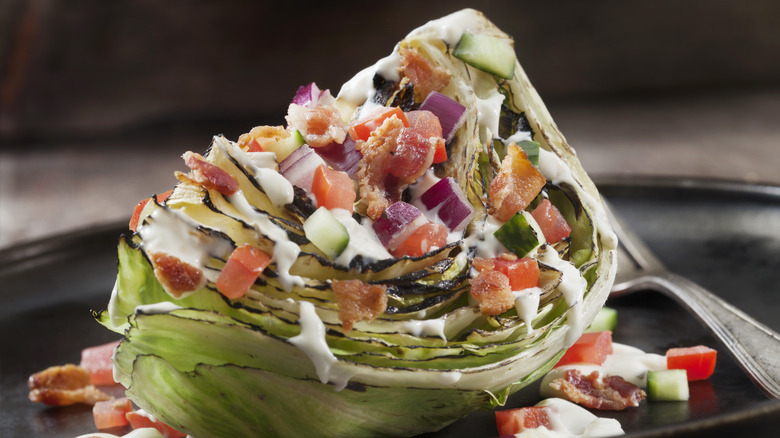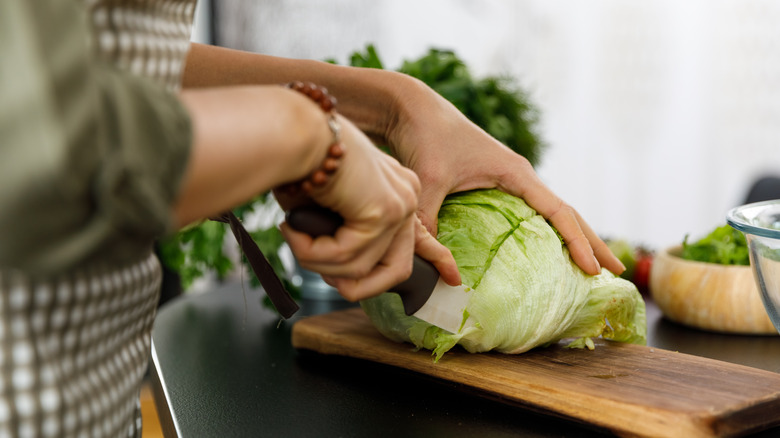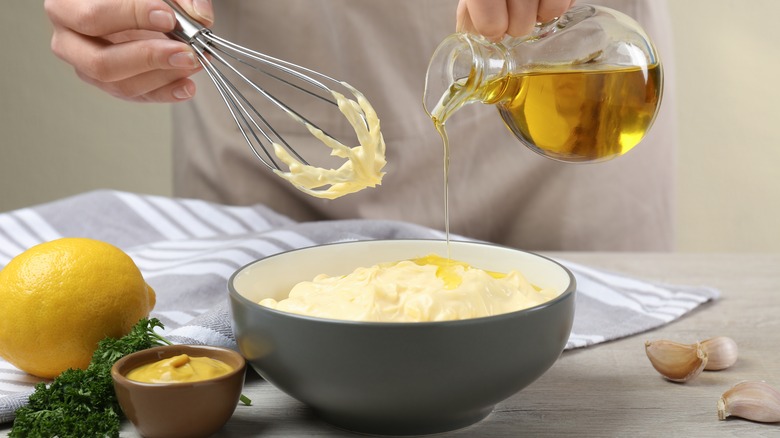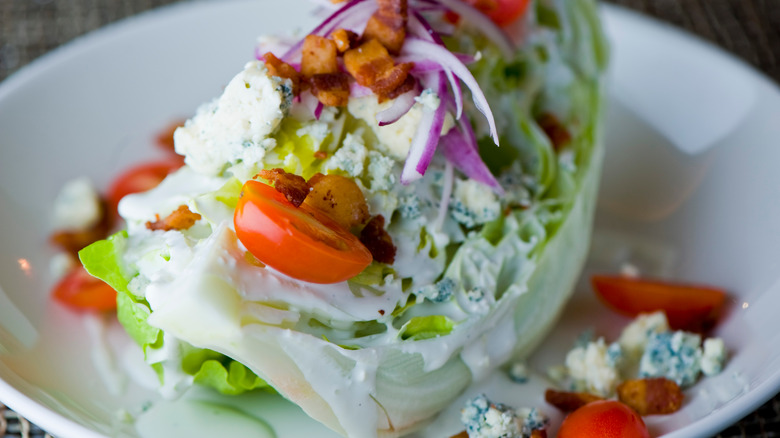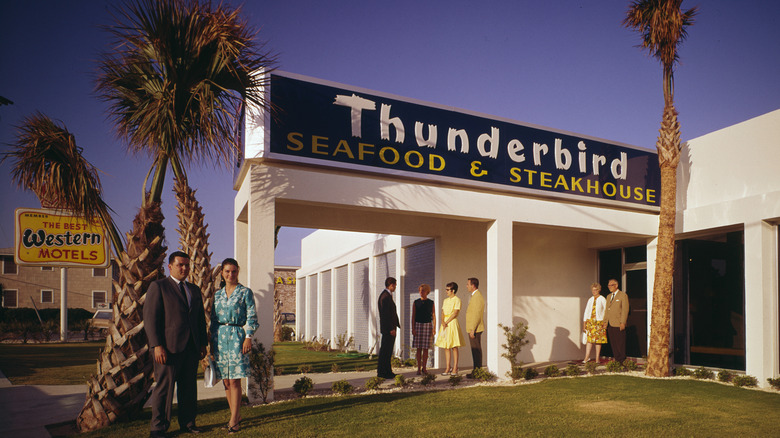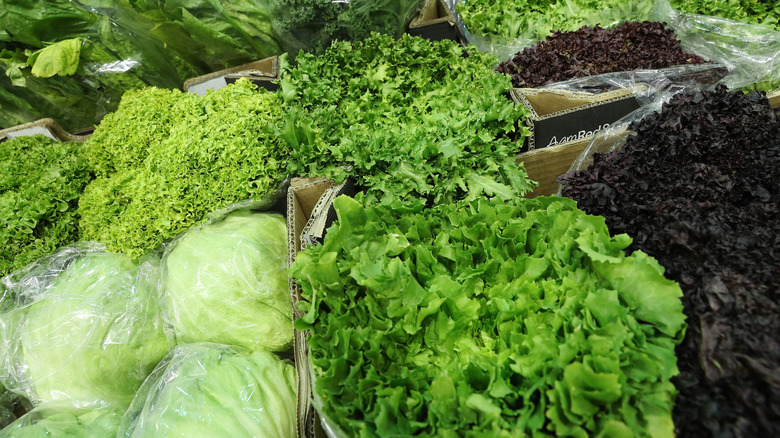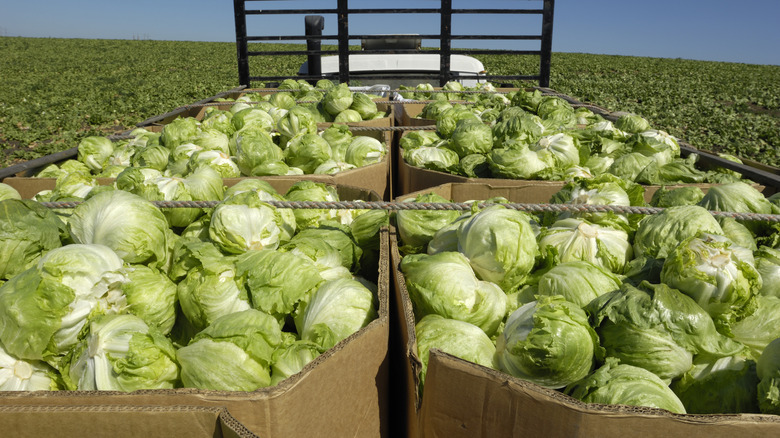The Rather Mysterious Origins Of The Classic Wedge Salad
If you have ever had dinner at a classic American steakhouse, you've probably tried a wedge salad. True to its name, this fantastic dish involves cutting a bed of iceberg lettuce into the shape of a wedge and serving it under a pile of toppings — a tactic that brings a bit of flare to your plate. Usually, these fun salads boast a hearty sprinkling of boiled eggs, red onions, and bacon bits, before being smothered in a thick, creamy sauce, such as blue cheese or ranch dressing.
Over the years, however, several other variations of the wedge salad have popped up in different restaurants. Even the most traditional wedge salads can include a twist, such as the addition of bread crumbs or chives. Meanwhile, more modern versions feature elements that give the salad a theme. Mexican wedge salads dress up the classic bacon and blue cheese mix with corn and cilantro. Greek wedge salads combine vinegar-based salad dressings with saltier ingredients such as olives and feta. At the end of the day, the charm of the wedge salad is that its neutral iceberg lettuce base combines beautifully with a variety of elements.
Although the relative diversity of the wedge salad is indisputable, the same cannot be said for its history. It is not exactly clear who invented the dish. From lettuce's Egyptian origins to its more modern reputation as an unhealthy eat, this is what we know about the history of the wedge salad.
Wedge salads have their origins in ancient Egypt
Many of the foods that Americans enjoy today simply did not exist 10,000 years ago. And, perhaps shockingly to some, lettuce is one of them. This leafy vegetable was actually developed by early farmers, who began breeding it around 6,000 years ago in Caucasus. As revealed by a Dutch research center at Wageningen University, the earliest iterations of lettuce were not even similar to the edible leaves that we know and love today. Instead, this early foliage was essentially impossible to eat because its leaves were covered in sharp thorns. As a result, people back in the day mostly used the crop to harvest seeds, which could then be pressed to make oil.
Interestingly, this situation slowly began to change over time. As the cultivation of lettuce spread from Caucasus to ancient Egypt, the genetic makeup of the plant transformed. Per a page published by the public learning library The Exploratorium, the ancient Egyptians likely began harvesting this plant as early as 2500 B.C. Although they originally used lettuce to make oil, these people eventually bred a type of leaf that is similar to modern-day romaine lettuce. While they did not necessarily use this type of foliage to make salads, archeological evidence suggests that they did use it for religious and medicinal purposes. Ultimately, the ancient creation of this phenotype began paving the way for the eventual invention of salad culture — including, of course, wedge salads.
Lettuce farming techniques spread to Europe
Naturally, the ancient Egyptian culture of lettuce farming spread across the Mediterranean and was adopted by the Greeks and Romans. According to a report published by Wageningen University, these Southern European cultures added their own touch to the cultivation of this plant. It is understood that these techniques made lettuce even easier to consume, altering its DNA so that it became distinct from the ancient oilseed lettuce harvested in other regions.
When the Roman empire began expanding across the European continent, lettuce cultivation entered into a new historic phase. As Roman citizens migrated from region to region, they brought their culture of lettuce harvesting along with them. This massive change not only contributed to the spread of lettuce cultivation, but also to an increase in agricultural innovations. After all, planting this crop in new environments often required the adoption of new techniques — and likely even other types of agrarian strategies that were already being used by conquered populations.
Because of this phenomenon, the genetic makeup of lettuce slowly started to evolve. As farmers altered their techniques, they were able to breed lettuce into a delicious leafy food item, as opposed to a weed covered in thorns. This brought farmers even closer to modern romaine lettuce. It also caused a culinary shift in which people began to enjoy lettuce as a leafy green side dish, rather than just a source of oil. Thus, the initial seeds of wedge salad culture were planted.
In the late 1800s, iceberg lettuce was introduced
As lettuce spread through Europe and, later, to the Americas, different agricultural innovations led to novel types of foliage. This led to an explosion in the number of lettuce varieties that you can find at any farm across the world. In fact, Wageningen University notes that approximately 1,500 different types of lettuce are currently being cultivated by humans. Meanwhile, another 1,000 varieties can be found in the wild. Among all of these varieties, one of the most popular is iceberg lettuce — the base that gives the modern-day wedge salad its distinctive shape.
Iceberg lettuce was first invented in the United States toward the end of the 19th century, and the plant's creation was far from accidental. During this time, a Pennsylvania-based agrarian enterprise known as the W. Atlee Burpee Company was making an active effort to introduce unique lettuce varieties into the U.S. market. Using several different research farms as a base, this company experimented with different types of seeds and breeding techniques in hopes of creating a totally unique type of foliage.
Luckily, in 1894, all this hard work paid off, and the company created the first cultivar for iceberg lettuce, bringing the world that much closer to the first-ever wedge salad. Shortly after the first iceberg lettuce came into the world, the W. Atlee Burpee Company began to grow it in California. People quickly fell for the product's light flavor and crunchy texture.
By 1916, wedge salads were appearing in cookbooks
Soon after iceberg lettuce was invented, the wedge salad was born. Mysteriously, though, it remains unclear exactly who came up with this fantastic dish. And, even more puzzling, there are not even any debates about which restaurant or chef served this salad first. In spite of all of this obscurity, though, we do know that one of the first wedge salad recipes came into print in 1916 — about 22 years after iceberg lettuce came into existence.
At this time, the prolific cookbook writer Marion Harris Neil published a 262-page tome titled "Salads, Sandwiches, and Chafing Dish Recipes," which contained an early version of the modern wedge salad. First known as a "Lettuce Salad with Roquefort Dressing," this dish did not always bear the creative name that we use today. However, for the most part, it was pretty similar to the current dish. Just like in our 21st-century recipe, Harris Neil's old-timey recommendations involved serving a plate of lettuce hearts under a serving of creamy blue cheese dressing. Additionally, she suggested sprinkling hard-boiled eggs on top — a custom that has hardly gone away in the last century or so.
Despite all these similarities, though, this old-fashioned wedge salad was not exactly the same as the ones we eat today. For one thing, it lacked the key ingredient of bacon bits. For another, it involved far more seasoning, calling for more flavorful ingredients like garlic and paprika.
Around this same time, salad dressing became more popular
If you examine Marion Harris Neil's 1916 wedge salad recipe, you will likely notice that the cookbook author provides full instructions for making blue cheese dressing by hand. Indeed, "Salads, Sandwiches, and Chafing Dish Recipes" recommends using a combination of oil, vinegar, mustard powder, and premium Roquefort cheese to give your foliage a burst of flavor. The rest of the book is not much different, suggesting several different ways to mix ingredients as diverse as cream, sherry wine, and egg yolks to create the perfect do-it-yourself salad dressing.
At more or less the same time that Harris Neil was writing her cookbook, American businesses were beginning to sell bottled dressing. As noted by the Association for Dressings and Sauces, the first quarter of the 20th century ushered in an exciting new phase for dressing sales. In 1912, New York City deli owner Richard Hellmann started selling homemade mayonnaise in jars. Just seven years later, Ohio-based restaurateur Joe Marzetti started selling European-style bottled dressings to patrons. By the mid-1920s, companies such as Kraft were gearing up to mass-produce their own dressings. The bottled dressing era was officially underway.
Of course, the increased availability of pre-made salad dressings meant that salad assembly was easier than ever. Making a wedge salad, or a similarly elaborate dish, no longer meant dedicating hours to perfecting one's homemade sauce. This would have likely contributed to salad's increased popularity during the Roaring Twenties.
Wedge salads and iceberg lettuce grew popular as refrigerators became more widely available
Even as wedge salad ingredients became more and more widespread across the United States, there was one factor standing in the way of the dish's popularity: a lack of efficient refrigeration. Before the days of electric refrigerators, it was not exactly easy to distribute perishable foods to customers in different parts of the country. After all, like many other kinds of foliage, iceberg lettuce has a tendency to wilt when exposed to heat for long periods of time. And, since iceberg lettuce was primarily produced in California, it was not always easy to keep the ingredient out of the heat.
During the initial transportation process, the W. Atlee Burpee Company was able to preserve its lettuce by shipping it in train cars full of giant ice blocks. However, as soon as the product arrived at its final destination, the company had no way to guarantee its quality. After all, as shown by the Pacific Standard, only 8% of American households had access to an electric refrigerator in 1930 — about 17 years after the technology was invented. This meant that most people were not able to keep their iceberg lettuce fresh.
As time went on, however, this began to change. Electric refrigerators grew popular among Americans, and, by 1944, 85% of U.S. households had one (via JSTOR). This allowed more people than ever to keep their iceberg lettuce cool and indulge in wedge salads.
During the 1950s, we had our first modern wedge salads
By the 1950s, the vast majority of American households had access to electric refrigerators, meaning that indulging in a perishable dish — such as a salad made of fresh lettuce, hard-boiled eggs, and cheese — was no longer as challenging as it had been in the past. What's more, around this same time, new cooling technology made it even easier for distributors to maintain the quality of their products during the transportation process. Thus, it is perhaps unsurprising that Americans started buying iceberg lettuce to an unprecedented degree. As noted by the National Museum of American History, by 1950, iceberg lettuce was the most consumed vegetable in the entire United States.
Naturally, as iceberg lettuce grew more popular, Americans looked for fun new ways to incorporate this ingredient into their meals. Wedge salads gained momentum — so much so that many people believe this dish actually originated during this time period.
Misconceptions aside, though, this era brought one major change to the composition of the wedge salad: the addition of bacon bits. Prior to the Nifty Fifties, wedge salads with bacon bits on top were essentially unheard of. By the end of the decade, however, this ingredient was standard. This era also saw an increase in the number of wedge salads that were topped with crumbled blue cheese bits in addition to the traditional blue cheese dressing.
Steakhouses made the wedge salad into a classic appetizer
During the 1970s, people enjoyed dining out, with steakhouses dominating the restaurant scene. Eateries like York Steakhouse, Beefsteak Charlie's, and Sizzler served up the traditional steak-and-potatoes meal that so many Americans loved — and they did so at a relatively reasonable price. This made steakhouses the Friday-night outing of choice for many members of the thriving middle class.
These locations tried to offer side dishes that were decadent enough to pair well with a huge slab of meat, and wedge salads were often the veggie option of choice. Thanks to the cool crunchiness of the iceberg lettuce and the rich pungency of the blue cheese element, wedge salads became the popular thing to serve with a nice, juicy steak. As a result, many people still associate wedge salads with the era of 1970s steakhouses, even thinking of the dish as a steakhouse wedge salad.
Unfortunately for wedge salad lovers, however, the 2000s have seen many steakhouses dropping this once-key menu item. As reported by Plate, many of the vintage-style steakhouses have been trying to make a comeback, competing for the business of younger generations such as millennials. In this process, though, these locales have often removed wedge salads from their menus. Ultimately, it seems, younger generations have not been so interested in the same menu items that their parents and grandparents once enjoyed.
With time, Americans grew interested in other types of lettuce
One of the reasons that wedge salads have lost their popularity among younger generations might have to do with Americans' increased interest in other types of lettuce. Back in 1963, when Julia Child starred in the first-ever season of her show, "The French Chef," iceberg lettuce was so ubiquitous that most Americans were not entirely familiar with all the other types of edible foliage they could serve. As a result, the late celebrity chef spent a large portion of her salads episode explaining what kinds of lettuce even existed — introducing Boston lettuce, frisée lettuce, and romaine. As for iceberg, Child kept her explanation short: "I'm just not going to show it to you."
Over time, though, America's iceberg lettuce obsession has declined, and interest in other types of lettuce has increased. As shown by Statista, in 2000, the average American only ate 8.4 pounds of romaine and leaf lettuce. However, by 2020, this number increased to 14.3 pounds per capita. (Julia Child would be so proud.) A separate report by Bloomberg found that 2020 also represented what it referred to as a "turning point" in consumer choices — for the first time in decades, Americans ate more leaf lettuce (like romaine or frisée) than iceberg. Overall, this reflected Americans' increased interest in new types of salad, such as kale salads, as well as the beginning of the end for wedge salads.
In the 2000s, wedge salads earned a reputation for being unhealthy
Generally speaking, we think of salads as a healthy dinner choice. However, during the early 2000s, the wedge salad came under fire for being one of the least nutritious options on the market. The reason for this is that iceberg lettuce was found to have significantly less nutritional value than other types of leafy vegetables. It offers low levels of vitamins C and A, especially when compared to romaine. This means that wedge salads are far from being the vitamin-packed dish that many healthy eaters are looking for.
What's more, many of the most traditional wedge salad ingredients are not exactly bursting with health benefits. As reported by Time, bacon is high in sodium, nitrates, and saturated fats. And, if that weren't bad enough, blue cheese dressing is high in sodium. According to the USDA, one 100-gram serving of this dressing contains 814 milligrams of sodium. Per the FDA, this means that a relatively small portion represents about 30% of your daily portion, although people who have a particular affinity for salad dressing could accidentally consume way more.
As a result of this somewhat disappointing reality, the early 2000s saw people rejecting wedge salads. In 2011, The Telegraph pronounced the world's iceberg lettuce craze "over." Eight years later, Vice called iceberg lettuce — and the salads that incorporate it — "an abomination." Wedge salads were out.
In 2017, wedge salads became associated with Donald Trump
When former reality TV star Donald Trump was elected president of the United States in 2016, his household gained a significant amount of media attention. Trump's eating habits became of particular interest for many Americans, with several news outlets exploring his preferences. Fascinatingly, the former president is believed to enjoy many of the foods that were once served at 1970s steakhouses. These are said to include steaks, potatoes, and, of course, wedge salads.
According to the book "The Grifter's Club," Trump has such an affinity for wedge salads that he has been known to choose this dish above all other veggie options. As the book alleges, "Trump wedge salads [are] a wedge of lettuce slathered in Roquefort dressing that is practically the only vegetable Trump will eat."
While it is difficult to confirm the veracity of this report, it is true that wedge salads are one of just five salads served at Trump Hotels. And, The Palm Beach Post has revealed that Mar-a-Lago's menu actually calls the dish "Mr. Trump's wedge salad." What's more, in 2017, CNN reported that the then-president was spotted chatting with the Japanese prime minister, Shinzo Abe, over (you guessed it) a couple of wedge salads. Overall, this has led many Americans to associate wedge salads with Trump, regardless of how they feel about the former president.
